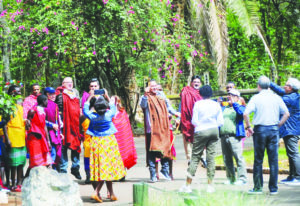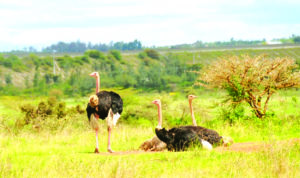By CK Nayak
 The Nairobi National Park in Kenya is a short drive away from its central business district. Wide-open grass plains and a backdrop of the city scrapers, scattered acacia bush play host to a wide variety of wildlife.
The Nairobi National Park in Kenya is a short drive away from its central business district. Wide-open grass plains and a backdrop of the city scrapers, scattered acacia bush play host to a wide variety of wildlife.
Established in 1946, the park is fenced on three sides, and the open southern boundary allows migrating wildlife to move around the park and the adjacent Kitengela plains. Despite its proximity to the city and its relatively small size, it boasts a large and varied wildlife population and is one of Kenya’s most successful rhinoceros sanctuaries.
Visitors can enjoy the park’s picnic sites, three campsites, and the walking trails for hikers all within just half an hour’s journey from the centre of the capital.
The park has a large and diverse wildlife population and animals found in the park include lions, leopards, African buffaloes, black rhinoceroses’, giraffes, hippopotamuses, spotted hyenas, blue wildebeests, zebras, cheetahs, gazelles, common elands , impalas, hartebeest, waterbucks, common warthogs, olive baboons, black-backed jackals, common ostriches, and Nile crocodiles.
 It is the main tourist attraction for visitors to Nairobi. Visitor attractions include the park’s diverse bird species, cheetahs, hyenas, leopards, and lions.
It is the main tourist attraction for visitors to Nairobi. Visitor attractions include the park’s diverse bird species, cheetahs, hyenas, leopards, and lions.
Other attractions include wildebeests and zebra migrations, the Ivory Burning Site Monument, the Nairobi Safari Walk, and the animal orphanage. Inhabitants of Nairobi and thousands of Kenyan children on school field trips visit the park every week.
Our tour guide, Kennedy says the park has five big (baring elephants), small fives, ugly fives, and many more fives including the shy five. The sight of animals in their natural surroundings and close to our armoured vehicles was like the films on the popular National Geographic Channel. But the best sight was that of a hungry lioness waiting for its kill – she was unmoved with our presence. The clicking of our cameras and whispering voices hardly had any impact on her.
After a breathtaking 15 minutes, she just walked away like a queen along the sides of our vehicle while other enthusiastic visitors peered out the window to catch a last glimpse of her.
According to Kennedy, the term “Big Five” originally referred to the difficulty in hunting lions, leopards, rhinos, elephants, and African buffaloes. These five large African mammal species were known to be dangerous and it was considered a feat by trophy hunters to bring them home. Today, however, the expression takes on a gentler form, referring to ‘seeing’ the Big Five—not shooting them. Kennedy also told us about many other fives the park has. The “Little Five” -ant lions, rhinoceros beetles, buffalo weavers, and leopard tortoises. There is even the Ugly Five- a whimsical listing of animals that includes hyenas, marabou storks, vultures, warthogs and wildebeests. The ‘Shy Five’ are hard to spot due to their introverted nature. These animals are- porcupines, bat-eared foxes, aardvarks, meerkats, and aardwolves.
Like all other parks, Nairobi National Park is being affected by the ever increasing human, and livestock population including poaching of wildlife. The park’s creator Mervyn Cowie designed several of Kenya’s national parks with human visitors in mind. This emphasis helped in making tourism Kenya’s primary industry.
Initially, it exacerbated problems between the human population and wildlife. The park is under pressure from the city’s growing population and needs for farmland. People live right next to the park’s boundaries, which creates human-animal conflicts.
To solve the problems, the government signed treaties with the local Maasai community who gave up their grazing lands on the Laikipia escarpment near Mount Kenya. Some of the park’s revenues have been used for community projects for the people in Kitengela. Maasai landowners have also formed the Kitengela Landowners Association, which works with the Kenyan Wildlife Service to protect the wildlife and find benefits for the locals. The farmers are compensated with cash if their livestock are killed by lions outside the park.
The park’s Wildlife Conservation Education Centre has lectures and videos about wildlife and guided tours of the park and animal orphanage. The Kenya Wildlife Service has also created a Safari Walk that highlights the variety of plants and animals that are in Kenya.
Above all, the entrance of the park is lined up with original Maasai people of all ages in their traditional attire, welcoming the visitors with their dance.



